Namibia does deserts
They say the Namib Desert, which stretches over the vast plains and mountains of central Namibia, is the oldest desert in the world. It certainly dominates the geography of the country and anyone moving from north to south or visa versa has to pass through it in one way or another. We didn’t so much pass through it as dive into it, starting in Swakopmund, down into Walvis Bay and then across the endless barren heart of the desert. And we were only getting started.
We’ve heard people say that driving across a desert is boring. They wouldn’t want to be in our car because we are talking about the desert all the time, its landscape, its texture and moods, its colours, its flora and fauna. We camped the first night behind a huge sandstone rock that rose out of the flat lifeless desert and the next morning spotted zebras, gemsboks, springboks and ostriches roaming across the sandy terrain. They may have been lonely but they were definitely not boring.
The desert changes with the time of day, the light rising over its vast distances, perhaps a few trees struggling in a dry creek bed, distant mountains showing different shades of red, yellow and grey. And then there’s the road, wide and dusty, sometimes smooth as silk, sometimes sandy and slippery, other times bone-jarring washboards that loosen your fillings.

Different colours, shapes and sizes in the desert but also different conditions and surfaces of the roads
We made our way across a rough side track to the rim of Kuiseb Canyon, carved by an ancient river of the same name, now exposing the twisted and layered strata of rock millions of years old. We crossed the Tropic of Capricorn, a symbolic line on the map which we last crossed heading northward a couple of months ago in Mozambique when the sign was in Portuguese.
And after more magnificent desert scenes and nerve-rattling washboards we hit the aptly named town, if you can call it that, of Solitaire. In the middle of this nothingness you drive through a gate and the town consists of petrol station, bakery, little supply shop and a very important (and busy) tyre repair shop. That’s it.
We decided our destination for the day would be the next town down the road, Sesriem, which acts as the Namib Naukluft National Park’s gateway to Sossusvlei, one of the must-see attractions of the Namib Desert. But despite the size of the large font on the map, and having briefly forgotten that Namibia has the second lowest population density of any country in the world, the ‘town’ of Sesriem consisted of a single complex containing a petrol station, a small shop and a campsite. And so ended our second day in the great Namib Desert.
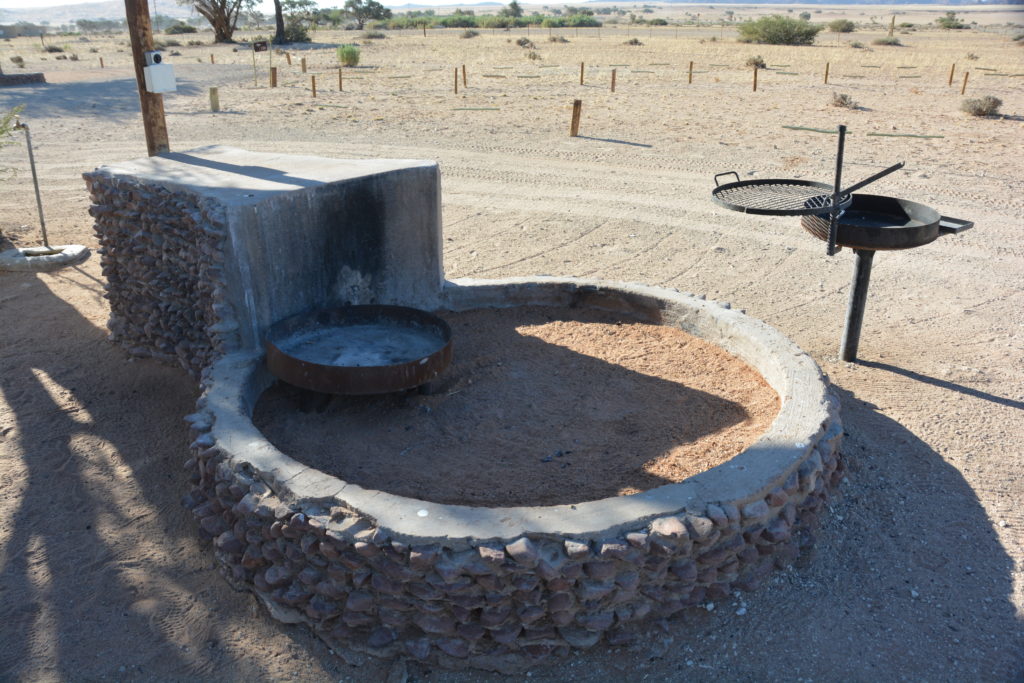
Africans love their braais, or barbeques, but I can’t always work out how to use them. This huge circular structure has a movable metal bin and a more traditional separate elevated braai with grill. Bit complicated, really.
The signature piece of any great desert is sand dunes, the taller the better. And in this regard the Namib is king. West of the outpost of Sesriem the desert stretches all the way to the ocean and is filled with mountains of beautiful red sand dunes. We entered the park again at 7am, just before dawn, and drove 65 kilometres past artistically perfect sand dunes coming alive in their bright colours as the sun rose, and after battling some seriously deep and soft sand we parked at the end of the road at what is called Sossusvlei. From here beautifully carved sand dunes rose all around us.
We had two targets for the morning before the sun reached out with its searing tentacles – climb the monster sand dune known as Big Daddy and walk amongst the dead acacia trees that remain standing on the Deadvlei Pan.
Big Daddy is one of those classically formed sand dunes with its sharp edge curving gracefully in wide arches as it climbs to the distant summit. The sand dune is 325 metres high, more than 1,100 feet, and is said to be one of the tallest in Namibia. Julie and I started our climb up its ridge, taking in the views as we slowly made our way up the sandy slope. And as we climbed the immense expanse of sand dunes made themselves known to us. The breeze was still just a little cool and the views were stunning.
At the halfway saddle before a very steep section of the ridge Julie chose to take in the views from a sitting position while I continued the climb upward, huffing and puffing, until I eventually made the summit of Big Daddy. And from here it seemed I had the whole world in front of me, or at least Namibia, with sand dunes stretching as far as I could see, a stunning landscape available almost nowhere else in the world. I had made my Everest. The route down was direct – straight down the steep face of Big Daddy, part skiing, part sliding, part holding on for dear life, above my ankles in sand on every footstep until I made the salt pan of Deadvlei and rejoined Julie. Quite an experience, to say the least.
Julie and I walked amongst these ancient dead acacia trees, some said to be 600 to 700 years old, featured on virtually every travel brochure or website of Namibia. These statues tell a story of how conditions have changed that allowed them once to prosper but now to be frozen in time. Very cool.
We drove out of the park and that afternoon headed ever southward, following another terrible road covered in deep washboards, the corrugation rattling us such that we could hard speak to each other. How Tramp survived it all is beyond wonder. The scenery continued to be stark but the desert gave us sharp colours of reds, oranges, yellows, greys, browns and blacks as we drove across open plains and through low mountain passes. We camped that night behind a petrol station at a remote intersection in a settlement called Betta, and so it was for betta or worst.
But the desert keeps on giving. We continued south, Tramp finding the sand-based tracks much more friendly than the gravel-based tracks, the stark lunar landscape with its vast distances and jagged rocky mountain perimeters were just fantastic. We spotted two families of bat-eared foxes, a rarity, and the usual suspects like gemsboks, ostriches and jackals. You’ve got to be tough to live out here.
Eventually we made the small town of Aus and at the small store at the petrol station Julie bought a sticker saying ‘I [heart] Aus’ which we thought was very appropriate and also lunched on their gemsbok sausage rolls and meat pies. Then it was onto the paved road and straight west to the small historic port town of Luderitz.

A herd of wild horses survive in the desert, having adapted over the generations to living in this harsh environment
Luderitz is an anachronism of African history, Germany’s last bastion of colonial existence. The town was Germany’s administration centre when it claimed what is now Namibia as its colony in the 1890’s and today it is a small outpost town clinging to that history with buildings featuring old Germanic architecture, German street names and a Lutheran Church dating back to 1909.
We explored the town a bit but then headed out on a dirt track that should have been called Moonscape Drive to the nearby Luderitz Penninsula which features a replica of a cross that Portuguese explorer Bartolomeu Diaz erected as the first European on this coast in 1498. The wind was howling like a Scottish golf course but we found a little shelter behind some rocks on the coast south of the old lighthouse and hunkered down for the cold and windy night.
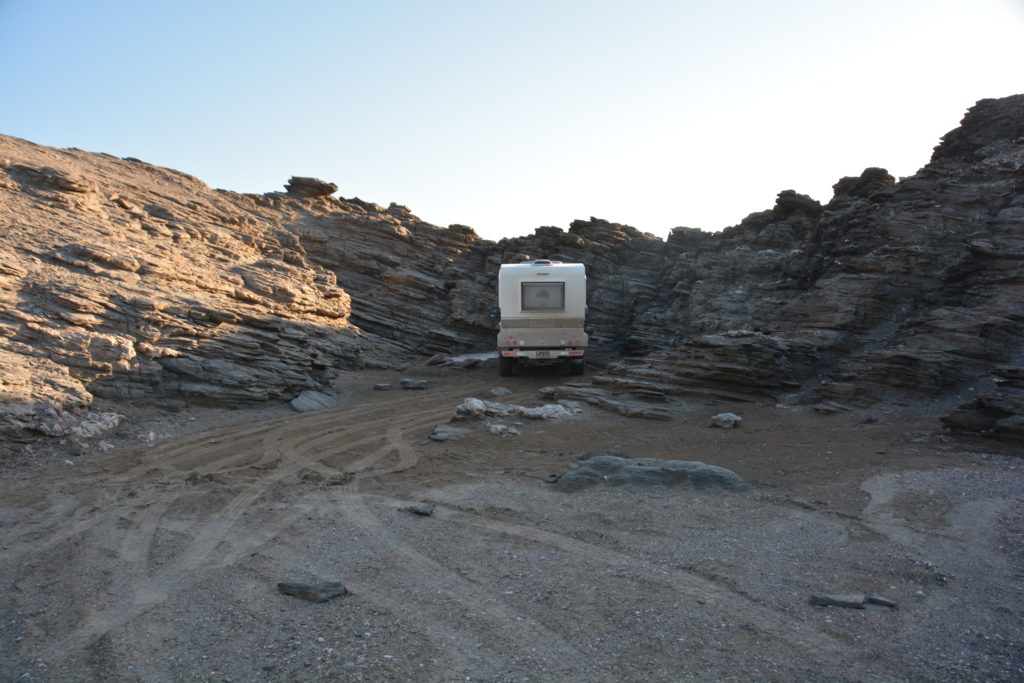
After a bit of wiggling we squeezed Tramp amongst these high rocks to protect us from the howling wind
We woke to a beautiful still morning and another slow leak flat tyre so filled it up and limped into Luderitz where the local tyre guy put patches on two different punctures. We’re not driving so much on tyres these days as pin cushions. We then headed east again, crossing the red rock splendour of this desert, highlighted by grand tabletop mesas that we sometimes drove around and sometimes drove up and over. We never tired of it which is just as well because there was a lot of it.
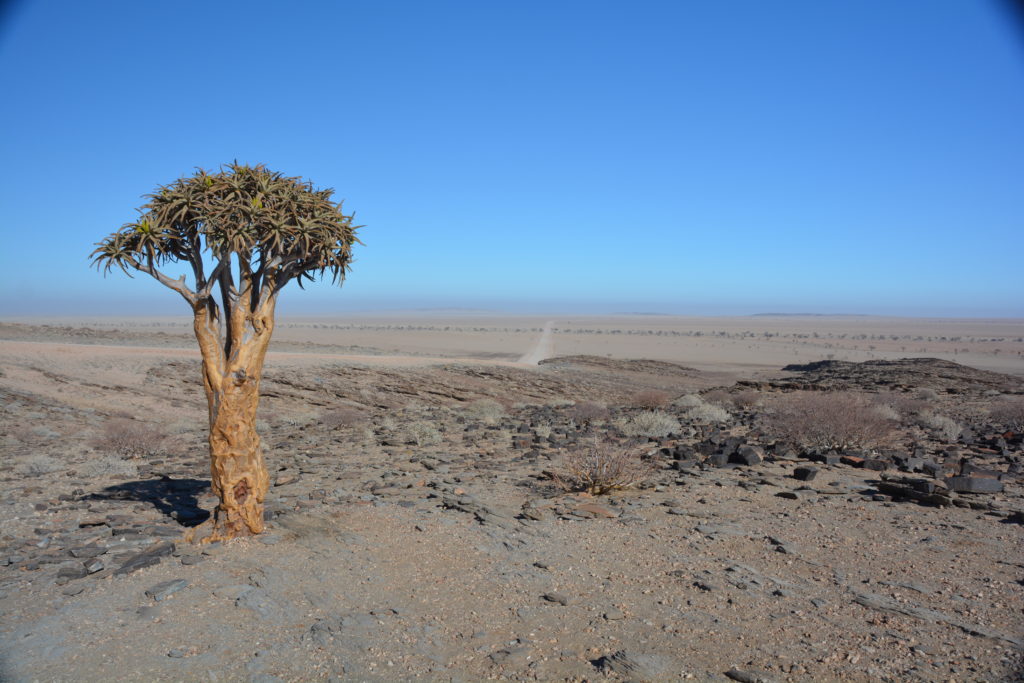
The fabulous quiver tree, Namibia’s national tree, unique in this part of the world, as old as the hills and as strange as trees come
A full driving day, mostly on paved roads but some long sandy stretches, saw us arrive at Fish River Canyon, one of Namibia’s premier natural attractions. We camped that night under a full moon, another braai, and some rare wifi. We had only one more night in Namibia but were savouring every moment.
Or was it? The next morning we drove to Fish River Canyon itself and gazed upon this amazing natural phenomenon from multiple vantage points. The geology completely escapes me but essentially it is a canyon within a canyon which first started to form up to two billion years ago in the time of Gondwana. Said to be the second largest canyon in the world after the Grand Canyon, we marvelled at the different layers of strata and sentiment on the steep walls leading down to the trickle of water. Fish River Canyon deserves its reputation as one of the go-to places in this part of the world.
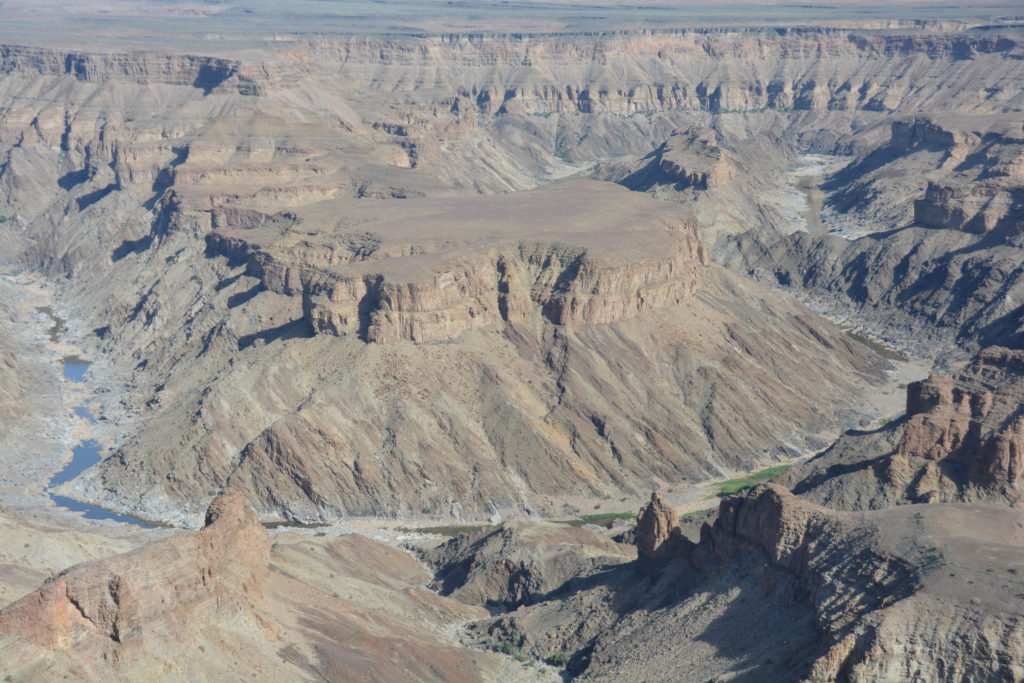
The magnificent Fish River Canyon, almost rivaling the Grand Canyon, in all its glory from its rim high above
We followed the winding dirt road up and down and through the red rock mountains until we popped out at the hot springs at a place called Ai Ais which is in the…wait for it…Ai Ais National Park. It was Easter weekend but they had room for us to camp and we set up on the banks of the Fish River after a relaxing swim in the warm spring waters of the huge swimming pool. The afternoon was lazy and relaxed, taking in the dramatic rock walls of the river canyon, talking to many fellow campers about Tramp – as always, and patting ourselves on the back for finding a way to extend our time in Namibia by one more night.
The next morning we finally, and reluctantly, made our way across more beautiful desert until we hit the Namibian border with South Africa. In short order we passed through both sides and were back in the country we started our circumnavigation of southern Africa. But Namibia had made a huge impression on us – the desert, the coastline, the history, the people and the animals were all top drawer and we will cherish our time here forever.
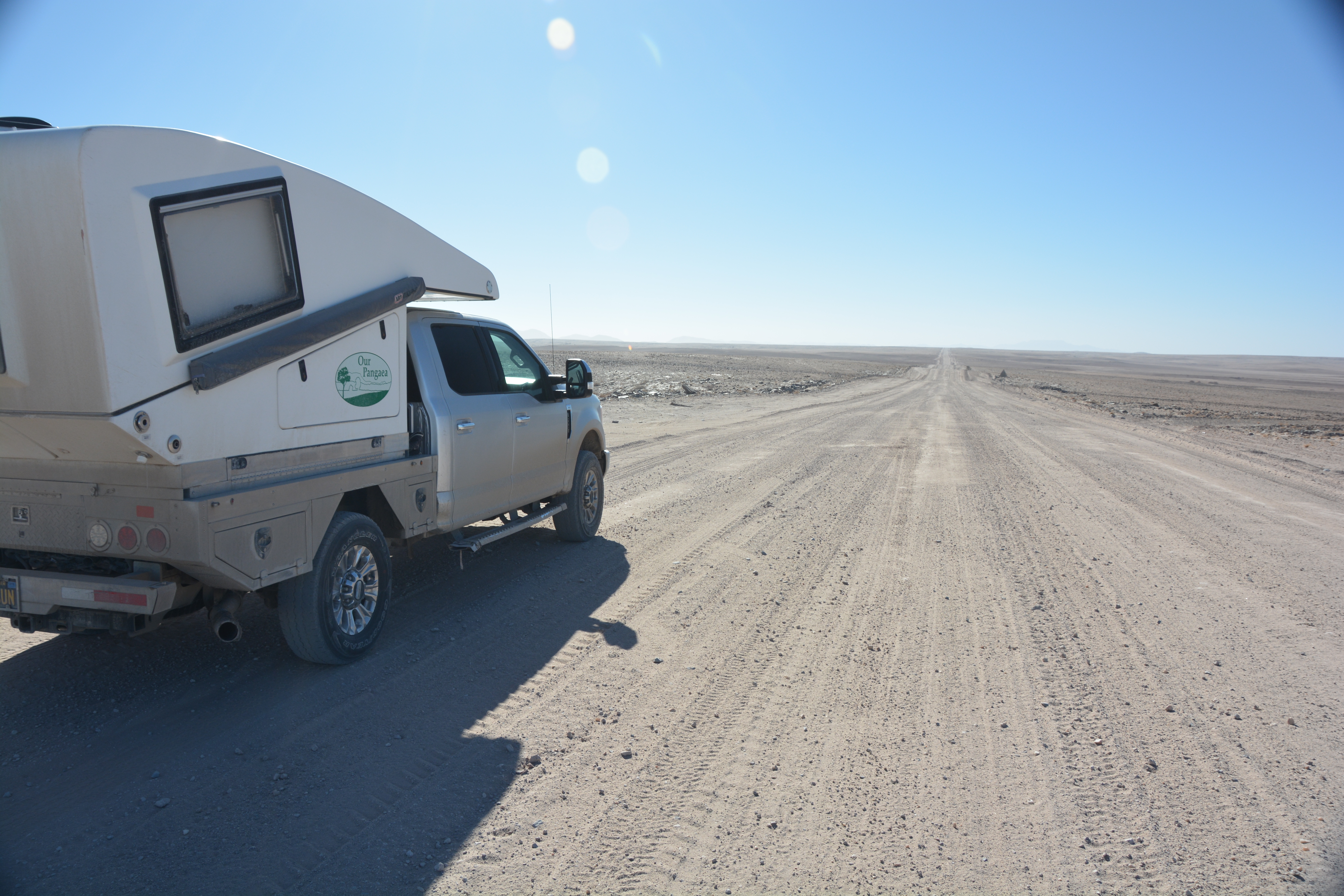

































Your photos make magic of the colours and textures of the desert. Amazing story and seems exciting in a different way to the Big 5
Hi Anne, yes we love the desert, both in the macro and in the micro, just great. And as you say, much different to the animals but its another fabulous dimension of Africa. See you soon (we hope!).
Bill